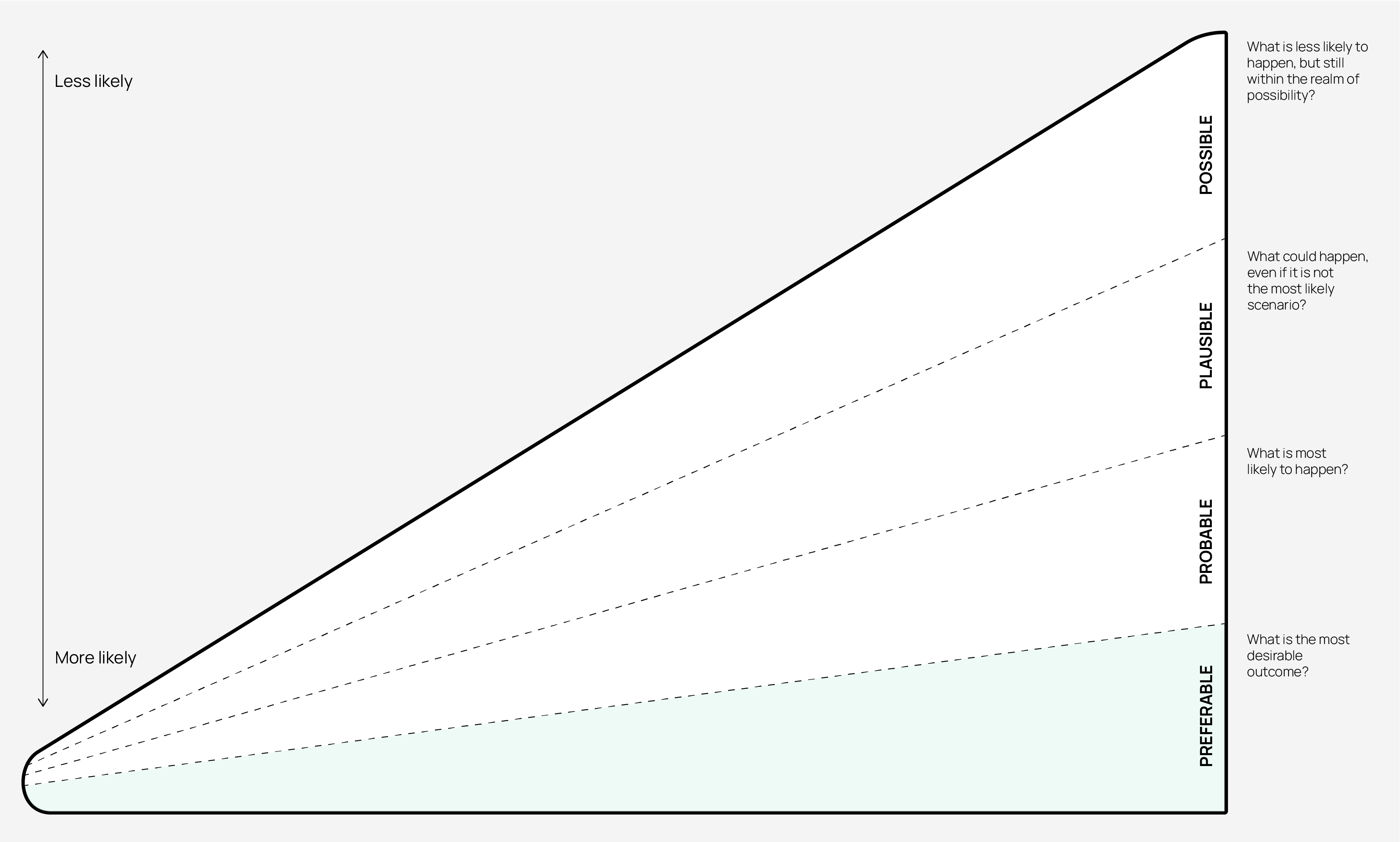Futures Cone
The Futures Cone is a tool that helps to visualise and explore different possible futures. It encourages thinking beyond the most likely outcomes and aids in strategy formulation and decision making.
Important concepts when using the futures cone include:
Preferable Futures: These are the futures an organisation desires or prefers based on its values, goals, and aspirations. Preferable futures can fall anywhere on the likelihood scale.
Probable Futures: These are the futures that are most likely to occur based on current trends and evidence.
Plausible Futures: These are futures that could realistically happen based on what we know today, but are less likely than probable futures.
Possible Futures: These are futures that could happen, but are less likely and may seem ‘far-fetched.’
The results
- A visual representation of the preferable, probable, plausible, and possible futures
- An understanding of key trends, drivers of change, and emerging issues that could influence the future
- An understanding of strategic options and pathways that the organisation can pursue
- An understanding of major risks that could impact future outcomes

When to use it
Strategic Formulation: When developing strategy
Policy Making: When developing policies that are resilient to future conditions
Innovation and R&D: When pursuing innovation or research and development projects
Risk assessment: When seeking to anticipate and prepare risks across a range of future scenarios
Strengths
Comprehensive
Encourages creative thinking
Strategic
Weaknesses
Can be complex
Requires an open mindset
Can be subjective
How to use it?
What do I need to start?
A clear objective.
Insights such as relevant data, current trends, and emerging patterns that can inform the exploration of futures.
How to use it?
Who to involve?
The Futures Cone is best explored with a team. Consider including:
- People with specialised knowledge in relevant areas such as technology or consumer trends.
- Stakeholders with a vested interest in the future being explored, including decision-makers and leaders.
Step by step
1
Define the scope
Clarify the purpose of mapping the futures cone. Ask questions like:
- What specific issues or questions are we addressing?
- Are we trying to predict specific outcomes, explore broad possibilities, or prepare for uncertainties?
- What is the scope of the topic:
- Is this a global analysis, regional, or local?
- What is the time period for consideration? Five, 10, 20 years or beyond?
2
Gather insights
Determine the best approach to gather insights. Ask questions like:
- What resources (budget, time, expertise) are available to conduct research?
- What data or information do we already have?
- What quantitative methods (surveys, analytics) might be useful?
- What qualitative methods (interviews, observations) might be useful?
- What are the best sources for this data?
Consider using PESTEL analysis to trigger thinking across different areas that may be relevant.
Undertake the research.
Analyse and summarise research findings with consideration for likelihood. Highlight the key trends, drivers of change, and emerging issues that could influence the future.
3
Develop future scenarios
Brainstorm different scenarios based on the research findings.
Begin by brainstorming Possible Futures—those that could happen, even if they seem unlikely or far-fetched.
Next, identify Plausible Futures—scenarios that could realistically occur based on current knowledge and trends.
Then, outline Probable Futures—the most likely scenarios given existing trends and evidence.
Through the process, ask questions like:
- What if…? For example, What if a major technological breakthrough occurs in this sector?
- How might…? For example, How might changes in consumer behaviour impact market dynamics?
- What are the implications of…? For example, What are the implications of stricter environmental regulations on industry practices?
Finally, define Preferable Futures—the futures that align with the organisation’s goals, values, and aspirations. Ask questions like:
- What would a best-case scenario look like?
- What would a worst-case scenario look like?
4
Consider implications
Implications: Consider how each scenario could impact the organisation. Consider both the immediate and long-term implications. Ask questions like:
- How might this scenario impact our operational processes and efficiency?
- How could this scenario impact our current competitive position?
- What changes in customer needs or preferences could occur in this scenario?
- What new technologies or innovations would be crucial to adapt to this scenario?
- How might regulatory requirements or compliance issues evolve in this scenario?
Challenges: Analyse potential obstacles and risks associated with each scenario. Consider the likelihood of these risks materialising and the potential impact on the organisation. Ask questions like:
- What of our resources (financial, human, etc.) might be insufficient to handle this scenario?
- What internal resistance might we face in adapting to this scenario?
- What technological barriers might hinder our ability to adapt to this scenario?
- What competitive threats might emerge in this scenario?
- What are the key risks associated with this scenario, and how likely are they?
It can be useful to use Risk Mapping to visualise challenges.
Opportunities: Explore how each scenario might open up new markets or create opportunities for innovation. Look for ways the organisation can capitalise on these changes. Ask questions like:
- How might this scenario open up new markets or customer segments for us?
- What innovative products or services could be developed in response to this scenario?
- How can we leverage emerging technologies to our advantage?
- What strategic partnerships or collaborations could be beneficial?
- How can we enhance our competitive edge or create a unique value proposition?
5
Develop action plans
Identify actions and interventions that will guide the organisation towards the preferred futures.
Prioritise these actions and use Road Mapping to outline the steps needed to achieve desired outcomes or mitigate risks.
Define triggers that will help to recognise which scenario is emerging.